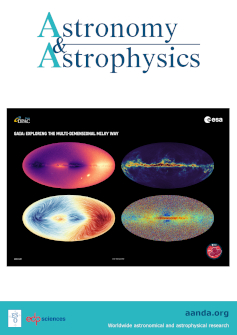The 𝒯ℛ𝒪𝒴 project
IF 5.4
2区 物理与天体物理
Q1 ASTRONOMY & ASTROPHYSICS
引用次数: 0
Abstract
Context. Co-orbital objects, also known as trojans, are frequently found in simulations of planetary system formation. In these configurations, a planet shares its orbit with other massive bodies. It is still unclear why there have not been any co-orbitals discovered thus far in exoplanetary systems (exotrojans) or even pairs of planets found in such a 1:1 mean motion resonance. Reconciling observations and theory is an open subject in the field.Aims. The main objective of the 𝒯ℛ𝒪𝒴 project is to conduct an exhaustive search for exotrojans using diverse observational techniques. In this work, we analyze the radial velocity time series informed by transits, focusing the search around low-mass stars.Methods. We employed the α-test method on confirmed planets searching for shifts between spectral and photometric mid-transit times. This technique is sensitive to mass imbalances within the planetary orbit, allowing us to identify non-negligible co-orbital masses.Results. Among the 95 transiting planets examined, we find one robust exotrojan candidate with a significant 3-σ detection. Additionally, 25 exoplanets show compatibility with the presence of exotrojan companions at a 1-σ level, requiring further observations to better constrain their presence. For two of those weak candidates, we find dimmings in their light curves within the predicted Lagrangian region. We established upper limits on the co-orbital masses for either the candidates and null detections.Conclusions. Our analysis reveals that current high-resolution spectrographs effectively rule out co-orbitals more massive than Saturn around low-mass stars. This work points out to dozens of targets that have the potential to better constraint their exotrojan upper mass limit with dedicated radial velocity observations. We also explored the potential of observing the secondary eclipses of the confirmed exoplanets in our sample to enhance the exotrojan search, ultimately leading to a more accurate estimation of the occurrence rate of exotrojans.𝒯ℛ𝒪𝒴 项目
背景在模拟行星系统形成的过程中,经常会发现共轨物体,也被称为 "特洛伊木马"。在这些配置中,行星与其他大质量天体共享轨道。目前还不清楚为什么迄今为止还没有在系外行星系统中发现任何共轨物体(外三叉星),甚至还没有在这种 1:1 平均运动共振中发现成对的行星。如何协调观测结果和理论是该领域的一个未决课题。𝒯ℛᵊ𝒴项目的主要目标是利用各种观测技术对外切星进行详尽的搜索。在这项工作中,我们分析了由凌日提供的径向速度时间序列,重点搜索低质量恒星。我们在已确认的行星上使用了α测试法,搜索光谱和测光中期凌日时间之间的偏移。这种技术对行星轨道内的质量不平衡很敏感,使我们能够识别不可忽略的共轨道质量。在所研究的 95 颗凌日行星中,我们发现了一颗具有显著 3-σ 探测结果的强健系外行星候选者。此外,有25颗系外行星在1-σ的水平上显示出了与系外行星伴星存在的兼容性,需要进一步的观测来更好地确定它们的存在。对于其中两个弱候选者,我们发现它们的光变曲线在预测的拉格朗日区域内有暗淡现象。我们确定了候选者和空探测器的共轨道质量上限。我们的分析表明,目前的高分辨率光谱仪可以有效地排除低质量恒星周围质量大于土星的共轨道。这项工作指出了数十个有可能通过专门的径向速度观测更好地限制其质量上限的目标。我们还探索了观测样本中已确认系外行星的二次日食的可能性,以加强对系外行星的搜索,最终更准确地估计系外行星的发生率。
本文章由计算机程序翻译,如有差异,请以英文原文为准。
求助全文
约1分钟内获得全文
求助全文
来源期刊

Astronomy & Astrophysics
地学天文-天文与天体物理
CiteScore
10.20
自引率
27.70%
发文量
2105
审稿时长
1-2 weeks
期刊介绍:
Astronomy & Astrophysics is an international Journal that publishes papers on all aspects of astronomy and astrophysics (theoretical, observational, and instrumental) independently of the techniques used to obtain the results.
文献相关原料
| 公司名称 | 产品信息 | 采购帮参考价格 |
|---|
 求助内容:
求助内容: 应助结果提醒方式:
应助结果提醒方式:


